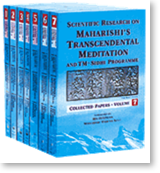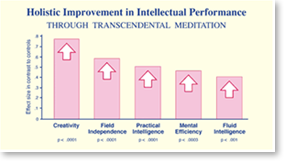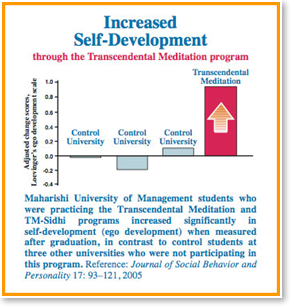 “Scientific Research on the Transcendental Meditation and TM-Sidhi Program: Collected Papers, Volume 7” is about to be released. It provides a wonderful resource for those investigating the ever-growing evidence of benefits results from the daily practice of the Transcendental Meditation technique.”
“Scientific Research on the Transcendental Meditation and TM-Sidhi Program: Collected Papers, Volume 7” is about to be released. It provides a wonderful resource for those investigating the ever-growing evidence of benefits results from the daily practice of the Transcendental Meditation technique.”
Over the past 50 years, hundreds of scientific research studies on the wide-ranging effects of the Transcendental Meditation technique have been published in more than 160 scholarly research journals. In order to make this research easily accessible to everyone, a series of volumes collecting these research studies started to be published beginning in the 1970s. The six previous volumes in this series cover the research from 1970 to 1996. The seventh volume of Collected Papers is now being printed, with 81 research papers published from 1996 to 2005. This new volume also lists all the findings in the previous 6 volumes.
Historical development of research on the Transcendental Meditation program
Starting in the earliest days of teaching the Transcendental Meditation technique, Maharishi Mahesh Yogi challenged scientists to conduct research on TM’s effects on the mind and body. The first person to take up Maharishi’s challenge was Dr. Keith Wallacehttp://www.ucla.edu/, who was then a doctoral student at the University of California, Los Angeles. His pioneering research confirmed that during Transcendental Meditation practice individuals experience a fourth major state of consciousness, a unique state of restful alertness, physiologically distinct from the states of waking, dreaming, and sleeping. This initial research, which was first published in the journal Science in 1970 and later in Scientific American in 1972, stimulated an avalanche of scientific studies in the subsequent years documenting the holistic and profound effects of the Transcendental Meditation technique for mind, body, behavior, and society. Due largely to this research, the study of consciousness became a topic of increasing interest to researchers around the world.
With each year the research has used progressively more sophisticated research designs and explored in more detail the mechanisms by which the Transcendental Meditation technique generates its unique effects. This development is clear in the research studies reprinted in Volume 7 of Collected Papers.
Three important examples from Volume 7
(1) EEG of Transcendental Consciousness and higher states of consciousness
EEG research studies reprinted in Volume 7 of Collected Papers include a series of studies by Dr. Fred Travis and his collaborators, which confirm and extend the previous findings on the effects of the Transcendental Meditation technique. For example, studies confirmed the finding that EEG coherence—orderliness of brain functioning—is higher during Transcendental Meditation compared to eyes close rest. EEG coherence is also higher during experiences of Transcendental Consciousness than during other experiences in Transcendental Meditation.
Studying changes in brain functioning during daily activity, Dr. Travis found that with long-term practice of Transcendental Meditation the EEG characteristics of Transcendental Consciousness become stable during daily life. This stabilization of Transcendental Consciousness is the hallmark of the fifth state of consciousness, Cosmic Consciousness.
(2) Improved cardiovascular health
The research papers of Dr. Robert Schneider and his associates reprinted in Volume 7 of Collected Papers provide deep insight into the benefits of the Transcendental Meditation technique for cardiovascular health.
For example, a longitudinal study using the most rigorous research design found a reduction in diastolic blood pressure among hypertensive patients over a one year period, as well as decreased use of blood pressure medication, in contrast to those taking a health education class.
Another study found reduced atherosclerosis of the carotid artery after nine months of practice of Transcendental Meditation, in comparison to controls. Atherosclerosis of the carotid artery is a risk factor for strokes.
A follow-up study of elderly patients with hypertension who learned the Transcendental Meditation technique showed a significant reduction in mortality rate—a 23% decrease in mortality overall and a 30% decrease in cardiovascular mortality, in comparison to control groups.
(3) Higher levels of cognitive functioning and personality integration
Studies reprinted in this latest volume of Collected Papers demonstrate holistic development of intellectual abilities and higher levels of personality integration among those who learn the Transcendental Meditation technique, even though this development usually does not occur after adolescence.
For example, three studies of secondary students in Taiwan found that those who learned the Transcendental Meditation technique, in comparison to control students who practiced other procedures, showed improvement in a broad range of mental abilities, including improved creativity, improved practical intelligence, increased mental efficiency, and increased abstract intelligence.
A 10-year longitudinal study found that university students regularly practicing the Transcendental Meditation technique displayed a dramatic increase in self-development to high levels of personality integration, in contrast to control groups of students from three universities. Of the students practicing the Transcendental Meditation technique, 38% of the group scored at a very high level of self-development, in contrast to only 1% of the control groups.

Volume 7 of Collected Papers is being printed, and is available for advance order
If you would like to order this volume as a reference for yourself and others, please visit: http://www.mumpress.com/books/scientific-research/b07.html
“This is the time when objective, science-based progress in the world is being enriched by the possibility of total development of human life on earth.”
—Maharishi, Life Supported by Natural Law, 1986, p. 35









